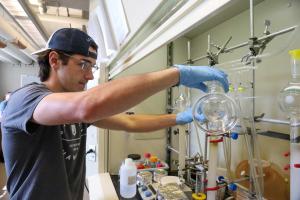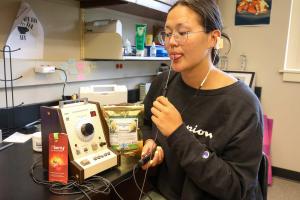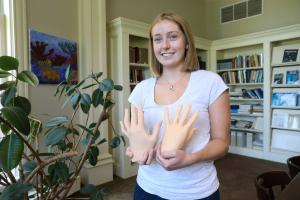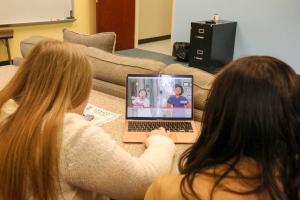Academic growth, learning and achievement certainly doesn’t slow down at Saint Anselm College in the summertime. More than a dozen students spent their days on campus conducting summer research throughout the warm season. This includes nine students working in Goulet through New Hampshire IDeA Network of Biomedical Research Excellence (NH-INBRE), a grant program that supports students' biomedical research and application. Also, three students in the Honors Program worked on projects related to drones, COVID-19 preparedness and feminist consciousness-raising literature. Here’s just a sampling of some of these interesting and important subjects.
Hannah Cotter '24 and Tyler Scopelites '24,
Majors: Natural Science
INBRE
Advisor: Chemistry Prof. Jen Pace

Cotter and Scopelites spent the summer working in the Chemistry Pace Lab on cancer research by making compounds that can later be used in preliminary biological studies. These compounds can hopefully be used as potential therapeutic agents for breast cancer, Cotter said.
The Pace Lab is focused on designing and synthesizing small molecule modulators that target cellular processes involved in human disease. These small molecule modulators will ultimately be used to further study these cellular pathways and more specifically, the role they play in disease onset and progression. Students working in the Pace Lab perform research at the interface of chemistry and biology – they synthesize their own molecules in the lab and test their biological activity in a variety of experiments.
Specifically, the Pace Lab is studying the Hippo signaling pathway. The Hippo pathway is a cellular process that plays a crucial role in cell proliferation, differentiation, and organ development. Tumor growth and cancers like pancreatic, breast, liver, and prostate is a result of dysregulation of the Hippo pathway.
Flannery Moore, ‘24
Major: Great Books Major
Honors Program research
Advisor: English Prof. Ann Holbrook
Moore spent time researching the role of consciousness-raising in the second wave feminist movement, which started in the 1960s. Moore focused on the ways in which feminist consciousness-raising fiction of the era shaped women’s political consciousness. Consciousness-raising (CR) is a form of group education that invites participants to share their personal experiences in a critical context. It was designed to enable groups of people oppressed by society to take an active, empowering role in their own education.
Feminist CR discussion groups and CR novels enabled women to see their individual experiences of marginalization as part of a larger cultural pattern. This increased consciousness could then be applied to political activism. CR fiction focused on women’s everyday experiences - including sexual assault and harassment, reproductive rights, sexism in the workplace, double standards regarding women’s sexuality, and complex relationships with motherhood.
Consciousness-raising at this time was limited in scope, however, largely excluding women of color, working class women, and lesbians. In her research, Moore explored the ways in which consciousness-raising as a discipline has shifted and expanded from the 1960s until now. Since the goal of CR is to connect personal matters with the political, it must include the diversity of marginalized experiences in order to truly be politically effective, Moore said.
Abigail Halterman ‘23
Major: Biology
INBRE
Advisor: Biology Prof. Shannon O’Leary
This summer, Halterman optimized a protocol for a rapid detection test of Atlantic salmon DNA. This is a collaborative project with the Meek Lab at Michigan State University. This test will benefit law enforcement and consumers, including restaurants. Law enforcement officers are interested in stopping the practice of illegal, unreported, and unregulated fishing.
The idea behind using the rapid test is for officials to know if a filet is a salmon or some other fish within 10-15 minutes in non-ideal or non-lab conditions. Consumers and even restaurants can confirm the legitimacy of the filets they are buying with the tests as well. Atlantic salmon is farmed in the ocean and costs about $12 per pound on the market. Wild-caught Pacific salmon goes for around $15-$30 per pound. There is a genetic difference between the Atlantic salmon and Pacific salmon, so a positive on the test strip does not equate to a positive for a Pacific salmon.
Halterman is also testing a variety of variables such as incubation time, incubation temperature, and DNA origin — to see how changing one variable affects the outcome of another. Ultimately, the research could lead to the development of a fast, cheap, and reliable test while limiting the amount of equipment needed.
Colleen Chen ‘23 and Margaret Malloy ‘23:
Behavioral Neuroscience
INBRE
Advisor: Psychology Prof. Adam Wenzel

Chen has been continuing the INBRE project that she’s been working on for the last two years with Psychology Professor Adam Wenzel. Chen’s research focuses on taste sensitivity while she studies chemical modifiers and their effect on taste thresholds.
A key tool in this research is called an electrogustometer, which uses electricity to determine how sensitive a person’s taste buds are. The chemical modifiers Chen is studying include gymnema sylvestre, a tea which blocks the perception of any sweet tastes. By using electricity to stimulate taste buds, she can measure participants' taste thresholds.
Chen said she is most looking forward to seeing how gymnema sylvestre affects those taste thresholds.

Malloy has been working with the Psychology Dept. to study perceptual illusions. She is focused on the effects of visual congruency on the rubber hand illusion. This is a famous perceptual illusion in which people associate touch with an alien limb that does not belong to their body.
To study this, Malloy created 17 visually congruent rubber hands, where she molded and created silicone versions of people’s hands that matched their size, shape, skin tone and other visual features. This work has implications for phantom limb, pain and other research in that area.
Gianna Cormier ‘24
Major: Psychology
INBRE
Advisor: Psychology Prof. Loretta Brady in the CRSEL Lab (Community Resilience and Social Equity Lab).
Gianna Cormier’s summer on the Hilltop focused on continuing her research using a Visual Novel Game (VNG) called Rounds. Cormier worked alongside Psychology Prof. Loretta Brady in the Community Resilience and Social Equity Lab. Rounds follows the perspective of a Latina emergency physician during a day in her life. Her experience as a physician, mother, friend, and community member is highlighted in each level. Throughout the story, she faces several personal and professional challenges and must respond to a devastating mass casualty incident in her community.

Games like Rounds are a form of Graphic Medicine which is a growing area of content that uses comics to bridge the gap between the healthcare world and the art world. This past school year, the comic book Rounds was turned into a video game using the VNG format that was converted from a mini graphic novel. Players practice what it’s like being an emergency medicine physician and get insight into the daily challenges of healthcare providers. Rounds helps young people from different cultural backgrounds develop an interest in these careers while promoting inclusion by exposing youth to people who look like them in the healthcare professions, Cormier said.
Cormier observed and collected data from different participant groups such as undergraduates, nursing faculty, and STEM educators who played the game, and noted how it affected them. Her goal was to gain player feedback as well as see where improvements can be made, because these engaging and interactive games can be a great resource for teachers.
At the Annual Graphic Medicine Conference in Toronto, Cormier and Brady presented “Graphic Medicine Education: The Creation of Visual Novel Games from Comics” which discussed the process of going from a mini comic to a Visual Novel Game with player interactions and a scripted storyline. Cormier said she appreciated the opportunity to expand her understanding of the correlation between health and policies, and how this can be seen in other communities.
Additional Honors research
James Biondi, a Computer Science and Information Systems double major, worked under the direction of Prof. Michael Huelsman of the Computer Science Department, to use machine learning for developing techniques that allow monocular drones to detect the depth of the surroundings in front of them. This would use a single, front-facing camera. Normally, depth perception requires two or more cameras. The real-world applications are significant, as is the basic research component.
Alexander Ginn researched the manner in which Covid-19 demonstrated the preparedness and capabilities of rural states, including New Hampshire, to fight epidemiological threats. Because of the manner in which the United States allows different states to set up their own health systems, Ginn examined this through a political science lens. He worked under the direction of Professor Jennifer Lucas of the Politics Department.
Special thanks to TheologyProfessor Ward Holder for additional information.
Related Links
- Community Engaged Learning offers new approach for Psychology Students →
- Students on Emergency Medical Service Team Gain Important Skills While Serving the College →
